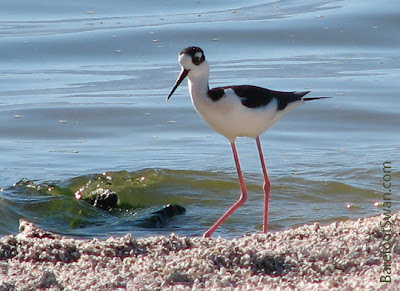 |
| First Annual Pelican Days Festival - Jan. 18-10, 2013 |
This past weekend we attended the First Annual Salton Sea Pelican Days birding festival.
The event was held at the Salton Sea State Recreation Area, just off Highway 111 on the east side of the sea.
The Sea and Desert Interpretive Association is the sponsor.
 |
| Watch for the blue sign, off HWY 111 |
 |
| Guided Public Bird Walk |
Lots of activities were planned for all ages including guided bird walks, a kids chalk art contest, Junior Rangers program, a kayak bird tour, lectures, and an evening campfire program.
There were also field trips to the Coachella Valley Wild Bird Center in Indio, Salt Creek and the Alamo River, and a tour of the Salton Sea History Museum.
Attendees had a choice of camping on site or just coming out for the day.
We spent most of the day birding, and there was plenty to see.
Some of the species we observed include:
 |
| Great Egret |
 |
| Snowy Egret |
Snowy Egret and Great Egret can look similar at a quick glance. Snowy is smaller, about 2 feet tall, and has a slim black bill and yellow feet. A good way to remember is to picture the SNOWY Egret is wearing yellow SNOW-shoes. (Thank you, Bob!) Great Egret is just over 3 feet tall, and has a yellow bill and black legs.
 |
| A distant Black-crowned Night Heron |
Black-crowned Night-Herons are pretty common, but not always seen. They feed mainly at night and like to roost in trees.
Adults have a dark head and back, and long white neck plumes that you can just see in the photo. Up close you can see they have red eyes.
This Great Blue Heron was roosting with its head and long neck tucked in against its body.
Great Blues are BIG - nearly 4 feet tall, with a 6 foot wingspan!
It's amazing that they can keep those long legs and toes from getting tangled up in the skinny branches.
 |
| Black Phoebe |
Black Phoebes have sleek black plumage on the head, back, tail and chest, and a white belly. They look like they are dressed to go to a formal event.
They are flycatchers, and often hunt their insect prey from a favorite perch.
 |
| Bonaparte's Gull |
At less than 14" long, Bonaparte's Gulls are noticeably smaller than the other common gulls. They are a winter visitor to our area.
During summer the breeding adult birds will have a black hood, instead of the winter "ear spot".
 |
| Black-necked Stilt |
Black-necked Stilts definitely have an appropriate name. They are about 14" high, and most of that is their spindly, bright pink legs.
Males have glossy black markings, while the females and juveniles are browner.
The "sand" in front of this Stilt is actually made up of tiny barnacle shells. The barnacles likely arrived in the 1940's, via military sea planes and Navy vessels that were brought to the Naval Test Base at the southwest corner of the Salton Sea.
 |
| Barnacle "Sand" |
And there were plenty of pelicans ...
 |
| American White Pelican |

Pelicans are fish eaters, using their large bills and throat pouches to scoop fish from the water as they swim.
They do not dive after fish from the air, like Brown Pelicans.

With a length of over 5 feet and a 9 foot wingspan, the American White Pelican is the second largest bird in North America - second in size only to the California Condor.
After spending most of the day at the Salton Sea, we watched a colorful sunset over the water as we drove back home.
"A wonderful bird is the pelican,
His bill will hold more than his belican.
He can take in his beak
Enough food for a week
But I'm damned if I see how the helican."
~ 1910 limerick by Dixon Lanier Merritt
(often attributed incorrectly to Ogden Nash)
For more information about the Salton Sea:
Sea and Desert Interpretive Association
www.seaanddesert.org
Salton Sea History Museum & Visitor Center
at the Desert Cahuilla Wetland
www.SaltonSeaMuseum.org
Salton Sea State Recreation Area (SRA)
www.parks.ca.gov/?page_id=639
Salton Sea Authority
http://www.saltonsea.ca.gov


No comments:
Post a Comment